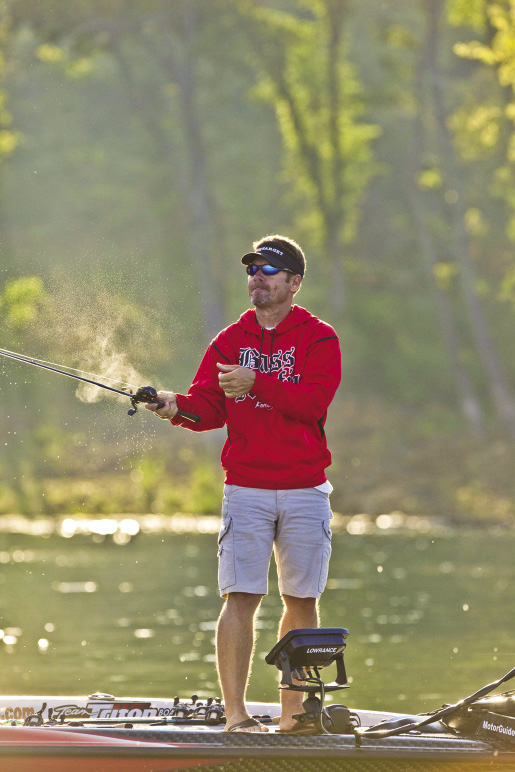
Stephen Browning grew up fishing near home on the Arkansas River. He moved to Hot Springs the first chance he got because so many of the bass pros he was reading about lived in that area.
“I felt there had to be some kind of magic there,” Browning says.
As much as Browning enjoys fishing the reservoirs around Hot Springs, he dotes on 29,000-acre Millwood Lake in Arkansas’ southwest corner. Giant largemouth of 10 pounds and more reside in Millwood’s sloughs and oxbows.
“It’s a cool place,” Browning says. “There are gators there that could eat a horse.”
SPRING
Browning calls Millwood a “stump-rich environment.” Countless cypress trees line the lake’s shallow sloughs. Many of the trees have broken off at the waterline. Their stumps are bass magnets, but they have also been the demise of many lower units, Browning warns.
Come springtime, Browning starts out in Bagley Slough on the western side of the lake. Its stumpy perimeter drops from roughly 3 feet into 6 to 8 feet of water. Browning triggers hard strikes by banging an orange/brown LiveTarget 60S Crawfish square bill crankbait over the knees of the cypress trees with a St. Croix Mojo Glass cranking rod and 16-pound Gamma Fluorocarbon.
A black-blue-purple 3/8-ounce flipping jig also puts Browning in touch with Millwood’s heavyweights. He tips the jig with a plastic chunk and pitches it to the stumps with a flippin’ rod and 20-pound fluorocarbon.
“You can hit 10 different targets before you need to move the boat,” Browning says.
When the bass are aggressive and willing to chase, Browning seines stumpy dropoffs with a 1/2-ounce War Eagle spinnerbait sporting a chartreuse-and-white skirt and gold-and-silver willowleaf blades.
As the bass get serious about spawning, they migrate to the shallow end of a slough or up onto a flat near the lip of a slough. Most of the beds are adjacent to stumps. You normally can’t see the spawning bass in the fertile water. The challenge is to find which of the many stumps hold a bass and where that bass is in relation to the stump.
Browning picks apart the maze by casting, flipping and pitching a 6-inch Texas rigged green pumpkin Z-Man LizardZ with a 1/4-ounce bullet weight. He hops it around stumps and swims it over scattered patches of hydrilla and peppergrass.
“I wouldn’t be surprised if Millwood produces the next state record largemouth,” Browning says.
SUMMER
 “In summer, I head for the lily pads with LiveTarget’s weedless frog and 65-pound braided line,” Browning says.
“In summer, I head for the lily pads with LiveTarget’s weedless frog and 65-pound braided line,” Browning says.
Browning fishes pad fields in 3 to 4 feet of water that drop into depths of 6 to 8 feet. There are plenty of bass in the pads along the edges of the sloughs. There may be even more bass in the pads along the upper, riverine portion of the lake.
“Mud Lake, an old slough off the main river, is also a great place to fish a frog,” Browning says.
On summer mornings, Browning starts out by twitching a frog over the pads. He stays with it as long as the bite continues. There are times when the frog bite lasts all day, but it normally fizzles when the sun sizzles.
That’s when Browning moves out to the river and fishes windfalls, brushpiles and other objects that break the current. The bass station themselves behind this cover where they can lounge and pick off any tidbits that wash by. Flipping and pitching a 1/2-ounce jig into this cover results in bass battles that resemble bare-knuckled brawls.
FALL
A deep crankbait, a Carolina rig and a dog-walking stickbait come into play when Browning fishes Millwood in autumn. Prime locations are ledges on channel bends and the mouths of sloughs where logs and brush have piled up beneath the surface. Browning calls such places “log washes.” They are typically 10 to 15 feet deep.
“I’ll pull some bass up by walking a big stickbait over that cover in the morning,” Browning says. “When the topwater bite dies, I bump the cover with a deep diving crankbait.”
The bass tend to stack up in autumn, so you’re likely to pick off several of them from one location, Browning adds.
Another excellent fall pattern is dragging a Carolina rigged lizard over points that lead into sloughs and oxbow lakes on the lower, more open part of the lake.
WINTER
“You can catch wintertime bass at Millwood by fishing the mouths of sloughs and oxbows with football jigs, crankbaits and jigging spoons,” Browning says. “But I have to admit that I’m usually deer hunting then.”
Browning hunts whitetails not far from Millwood, and he claims the region yields trophy bucks. It’s just one more reason you can’t wedge him out of Arkansas.
Visit Bassmaster.com/Arkansas for more on Arkansas bass fishing.





